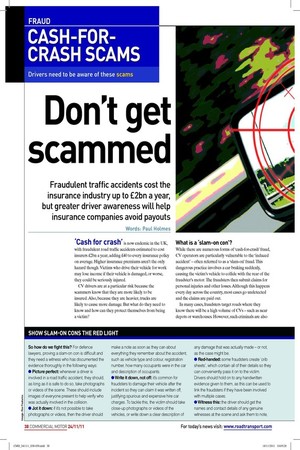Don’t get scammed
Page 30

Page 31

If you've noticed an error in this article please click here to report it so we can fix it.
Fraudulent traffic accidents cost the insurance industry up to £2bn a year, but greater driver awareness will help insurance companies avoid payouts
Words: Paul Holmes
‘Cash for cra sh’ is now endemic in the UK, with fraudulent road trafic accidents estimated to cost insurers £2bn a year, adding £40 to every insurance policy on average. Higher insurance premiums aren’t the only hazard though. Victims who drive their vehicle for work may lose income if their vehicle is damaged, or worse, they could be seriously injured.
CV drivers are at a particular risk because the scammers know that they are more likely to be insured. Also, because they are heavier, trucks are likely to cause more damage. But what do they need to know and how can they protect themselves from being a victim?
What is a ‘slam-on con’?
While there are numerous forms of ‘cash-for-crash’ fraud, CV operators are particularly vulnerable to the ‘induced accident’ – often referred to as a ‘slam-on’ fraud. This dangerous practice involves a car braking suddenly, causing the victim’s vehicle to collide with the rear of the fraudster’s motor. The fraudsters then submit claims for personal injuries and other losses. Although this happens every day across the country, most cases go undetected and the claims are paid out.
In many cases, fraudsters target roads where they know there will be a high volume of CVs – such as near depots or warehouses. However, such criminals are also opportunistic and sometimes it is the unfortunate case of a driver being in the wrong place at the wrong time.
How the fraudsters operate
The way the scammers carry out induced accidents is varied. Often, they will commit the offence at a roundabout, pulling partly onto the road but then slamming on the brakes for no reason.
Other times, two cars will work together to make the incident look more authentic. For example, a stooge car will pull onto the roundabout, giving the fraudsters more of a reason to justify braking.
Sometimes, a stooge car will simply swerve off into a side road, giving the fraudsters the excuse that they need to slam on their brakes. There are even cases when those involved disconnect their brake lights so that other motorists aren’t given any warning of when they are about to come to a halt.
Big bucks
The money involved in these schemes is substantial. It would not be unusual to have four or ive individuals each claiming for whiplash, as well as a written-off vehicle, a £10,000 hire claim and legal fees costing up to £50,000.
There are hundreds of these cases every year. Because of the way they are set up, it would be easier to defend cases if the victims knew about the scam, how it worked and what they can do if they ind themselves in this situation.
People who orchestrate slam-on cons are usually involved with more than one case, with some selling the claims on to solicitors. The individuals driving the vehicles are often experienced at inducing a CV to collide with the rear of their vehicle and are recruited speciically for that purpose.
The people who claim they were in the car and were injured are also enlisted by the same person who set up the fraud. More often than not, these people, known as ‘phantom passengers’ , were not actually in the car.
To maintain authenticity, they will normally visit their GP, hospital or walk-in centre in the days following the accident to claim they are suffering whiplash. In these cases, there may have been only one or two people in the vehicle, but claims are made for four or ive. ■
● Paul Holmes is a partner at law irm DWF













































